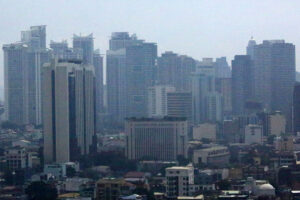MANILA remained the third most affordable city for prime office rents in the Asia-Pacific region in the third quarter, according to real estate consultancy Knight Frank.
On an annual basis, Manila’s occupancy cost fell by 1.7%, slightly below the average 2.5% decline in the region, a Knight Frank Asia report released on Oct. 22 showed.
The average prime office cost in Manila was $29.64 per square foot (sq.ft.) in the July-to-September period.
“Prime rents in the region fell just 0.1% on a quarter-on-quarter basis, signaling that rents could be bottoming out, supported by growth in Indian markets,” Knight Frank said.
Kuala Lumpur had the lowest average prime office rent in the region at $20.57 per sq.ft., followed by Jakarta with ($26.75), Phnom Penh ($34.13), Guangzhou ($35.60), and Bengaluru ($36.17).
The most expensive rent for prime office space was in Hong Kong SAR ($155.52), followed by Singapore ($125.66), and Sydney ($99.75).
Knight Frank expects Manila to see a decline in rents in the next 12 months, along with Bangkok, Beijing, Guangzhou, Hong Kong, Shenzhen, and Shanghai.
Cities that will see higher rents in the next 12 months include Brisbane, Perth, Ho Chi Minh City, Singapore, Taipei, Seoul and Sydney.
The average prime office vacancy rate in the Asia-Pacific region slipped by 0.2% quarter on quarter to 14.8% in the third quarter, ending consecutive quarterly increases since the second quarter of 2022.
Manila had the 11th highest prime office vacancy rate in the region at 14%. Kuala Lumpur had the highest at 27%, followed by Shenzhen (25.1%), Jakarta (24.9%), Bangkok (24%) and Shanghai (21.1%).
Knight Frank said companies across the region are keeping a close eye on costs amid slower economic growth and geopolitical risks. It noted that leasing sentiment will likely take a hit as firms curb spending.
“Global economic uncertainties have led to more cautious capital expenditure strategies among occupiers, favoring renewals and consolidating office footprints,” Tim Armstrong, Global Head of Occupier Strategy and Solutions said.
Companies that relocate their offices usually opt for smaller spaces, “aligning with cost mitigation needs and the growing acceptance of hybrid work models,” he added.
“While the business sentiment may improve as the Fed eases monetary policy, demand will continue to be tempered by prudent spending and workplace strategies focused on maximizing space utilization,” Mr. Armstrong said.
Knight Frank said the Asia-Pacific prime office sector will still be “tenant favorable” this year. With the delivery of around 12 million square meters (sq.m.) this year, the pipeline supply next year will likely drop by about one-fifth.
“However, as the development peak in the region subsides, any significant uptick in leasing activity could rapidly tighten the availability of prime spaces. This scenario may accelerate the flight-to-quality trend as tenants seek to upgrade their portfolios in a potentially more competitive market,” Mr. Armstrong said. — Aubrey Rose A. Inosante
